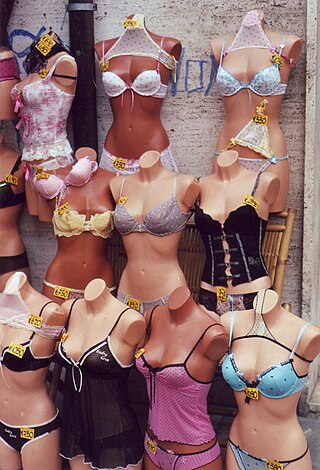
Lingerie is a category of primarily women's clothing including undergarments, sleepwear, and lightweight robes. The choice of the word is often motivated by an intention to imply that the garments are alluring, fashionable, or both. In a 2015 US survey, 75% of women reported having worn "sexy lingerie" in their lifetime.
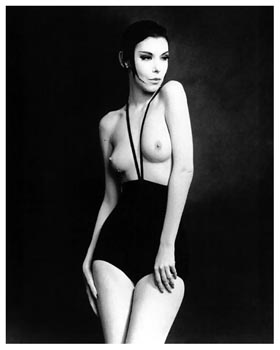
The monokini was designed by Rudi Gernreich in 1964, consisting of only a brief, close-fitting bottom and two thin straps; it was the first women's topless swimsuit. His revolutionary and controversial design included a bottom that "extended from the midriff to the upper thigh" and was "held up by shoestring laces that make a halter around the neck." Some credit Gernreich's design with initiating, or describe it as a symbol of, the sexual revolution.
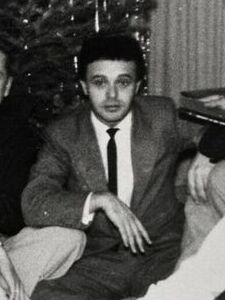
Rudolf "Rudi" Gernreich was an Austrian-born American fashion designer whose avant-garde clothing designs are generally regarded as the most innovative and dynamic fashion of the 1960s. He purposefully used fashion design as a social statement to advance sexual freedom, producing clothes that followed the natural form of the female body, freeing them from the constraints of high fashion.

Fruit of the Loom is an American company that manufactures clothing, particularly casual wear and underwear. The company's world headquarters is located in Bowling Green, Kentucky. Since 2002, it has been a wholly owned subsidiary of Berkshire Hathaway.

The Wonderbra is a type of push-up underwire brassiere that gained worldwide prominence in the 1990s. Although the Wonderbra name was first trademarked in the U.S. in 1955, the brand was developed in Canada. Moses (Moe) Nadler, founder and majority owner of the Canadian Lady Corset Company, licensed the trademark for the Canadian market in 1939. By the 1960s the Canadian Lady brand had become known in Canada as "Wonderbra, the company." In 1961 the company introduced the Model 1300 plunge push-up bra. This bra became one of the best-selling Canadian styles and is virtually identical to today's Wonderbra.

Cleavage is the narrow depression or hollow between the breasts of a woman. The superior portion of cleavage may be accentuated by clothing such as a low-cut neckline that exposes the division, and often the term is used to describe the low neckline itself, instead of the term décolletage. Joseph Breen, head of the U.S. film industry's Production Code Administration, coined the term in its current meaning when evaluating the 1943 film The Outlaw, starring Jane Russell. The term was explained in Time magazine on August 5, 1946. It is most commonly used in the parlance of Western female fashion to refer to necklines that reveal or emphasize décolletage.
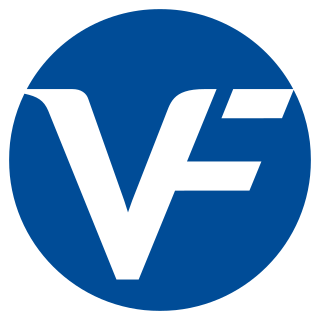
VF Corporation is an American global apparel and footwear company founded in 1899 by John Barbey and headquartered in Denver, Colorado. The company's 13 brands are organized into three categories: Outdoor, Active and Work. In 2015, the company controlled 55% of the U.S. backpack market with the JanSport, Eastpak, Timberland, and The North Face brands.
Margaret Anne "Peggy" Moffitt is a former American model and actress. During the 1960s, she worked very closely with fashion designer Rudi Gernreich, and developed a signature style that featured heavy makeup and an asymmetrical hair cut.

A handbra is the practice of covering female nipples and areolae with hands or arms. It often is done in compliance with censors' guidelines, public authorities and community standards when female breasts are required to be covered in film or other media. If the arms are used instead of the hands the expression is arm bra. The use of long hair for this purpose is called a hair bra.

The history of bras is closely tied to the social status of women, the evolution of fashion, and shifting views of the female body over time.

Male bra – also known as a compression bra, compression vest, or gynecomastia vest – refers to brassieres that are worn by men. Men sometimes develop breasts and the estimates of those with the condition are presented as a range "because the definition of gynecomastia varies and the method of surveying varies." Although there are options for treating gynecomastia, some elect surgery to reduce their breasts or wear a male bra. Male bras typically flatten rather than lift.

Bra size indicates the size characteristics of a bra. While there is a number of bra sizing systems in use around the world, the bra sizes usually consist of a number, indicating the size of the band around the woman's torso, and one or more letters that indicate the breast cup size. Bra cup sizes were invented in 1932 while band sizes became popular in the 1940s. For convenience, because of the impracticality of determining the size dimensions of each breast, the volume of the bra cup, or cup size, is based on the difference between band length and over-the-bust measurement.
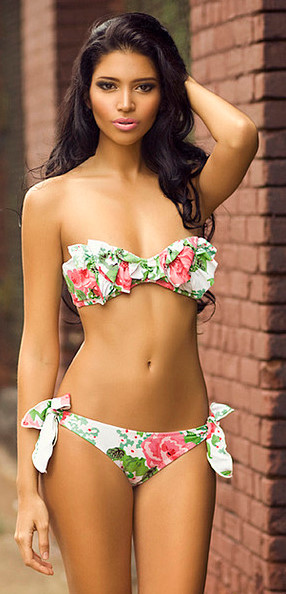
A bandeau is a garment comprising, in appearance, a strip of cloth. Today, the term frequently refers to a garment that wraps around a woman's breasts. It is usually part of a bikini in sports or swimwear. It is similar to a tube top, but narrower. It is usually strapless, sleeveless, and off the shoulder. Bandeaux are commonly made from elastic material to stop them from slipping down, or are tied or pinned at the back or front. In the first half of the 20th century, a "bandeau" was a narrow band worn by women to bind the hair, or as part of a headdress.
A bra, short for brassiere or brassière, is a form-fitting undergarment that is primarily used to support and cover a woman's breasts. A typical bra consists of a chest band that wraps around the torso, supporting two breast cups that are held in place by shoulder straps. A bra usually fastens in the back, using a hook and eye fastener, although bras are available in a large range of styles and sizes, including front-fastening and backless designs. Some bras are designed for specific functions, such as nursing bras to facilitate breastfeeding or sports bras to minimize discomfort during exercise.

A training bra is a lightweight brassiere designed for girls who have begun to develop breasts, at Tanner stage II and III. The training bra is intended to be worn during puberty when the breasts are not yet large enough to fit a standard-sized bra. Training bras often provide minimal or no support, and may serve aesthetic purposes to fulfill cultural norms and local beauty standards.

Underwear, underclothing, or undergarments are items of clothing worn beneath outer clothes, usually in direct contact with the skin, although they may comprise more than a single layer. They serve to keep outer clothing from being soiled or damaged by bodily excretions, to lessen the friction of outerwear against the skin, to shape the body, and to provide concealment or support for parts of it. In cold weather, long underwear is sometimes worn to provide additional warmth. Special types of undergarments have religious significance. Some items of clothing are designed as undergarments, while others, such as T-shirts and certain types of shorts, are appropriate both as underwear and outerwear. If made of suitable material or textile, some underwear can serve as nightwear or swimwear, and some undergarments are intended for sexual attraction or visual appeal.

Many stylistic variations of the bikini have been created. A regular bikini is a two-piece swimsuit that together covers the wearer's crotch, buttocks, and breasts. Some bikini designs cover larger portions of the wearer's body while other designs provide minimal coverage. Topless variants are still sometimes considered bikinis, although they are technically not a two-piece swimsuit.

An underwire bra is a brassiere that utilizes a thin, semi-circular strip of rigid material fitted inside the brassiere fabric to help lift, separate, shape, and support a woman's breasts. The wire may be made of metal, plastic, or resin. It is sewn into the bra fabric and under each cup, from the center gore to under the wearer's armpit. Many different brassiere designs incorporate an underwire, including shelf bras, demi bras, nursing bras, and bras built into other articles of clothing, such as tank tops, dresses and swimsuits.
Kestos is a British lingerie brand founded in London in 1925 by British designer Rosamund Lilian Klin, (1899-1949) the wife of a Russian artist living in London. Kestos' major innovation to the feminine underwear in the 1930s was the development of the two separate cups model. Rosamund Klin, director of the Kestos Corset Company, started experimenting with a pair of hankies, just like Caresse Crosby back in 1913. Kestos' bra was the first commercially produced brassiere that had two distinct and defined cups and "the Kestos" became a generic trademark bra. Kestos was distributed in the US, UK, Canada, Australia, France as well as some other European countries and was popular through the 1930s, 1940s and into the early 1950s. The Copmpany went into liquidation in 1967 prior to the death of the Chairman Leo Klin (1877-1967).
















